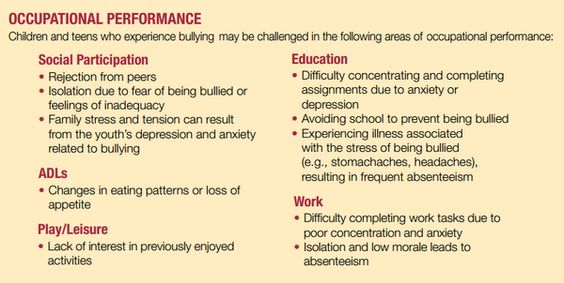With signs in the classroom, it can become apparent that certain children could benefit from Occupational Therapy. OT can make a big impact on the child’s social skills, sensory integration, and fine motor/gross skills. Further, in the school setting, Occupational Therapy for bullying is also used.
Bullying occurs every day and is a common fear in parents of children or teenagers. There are many consequences of bullying that include mental and physical health challenges, as well as occupational performance difficulties.

source: www.aota.org
OT’s Role in Bullying Prevention
OT knowledge in mental health and child development allow effective Occupational Therapy for bullying. This happens by collaborating with youth, educators, families, and others to facilitate friendship and socialization by environmental modifications. There are many bullying resources for Occupational Therapists provided by The American Occupational Therapy Association (AOTA).
It is also important that educators and OT’s understand the three categories of participants in bullying: bullies, victims, and bystanders.
Bullies, Victims, and Bystanders
Bullies
Children who bully others do so in a variety of ways. Physical and verbal aggressions are two popular forms of bullying, along with intimidation and domination. They can also use relational aggression, in which they ignore or exclude another child. Bullies can easily identify targets, choosing children with few friends or those who respond to the bullying passively. Most bullying happens when adults are not around. Occupational Therapy for bullying can benefit children who bully to help develop social skills, cooperative behavior, and empathy for others.
Victims
Most victims of bullying tend to appear as “different” from others. It is important to pay attention to those children who isolate themselves from activities, have trouble making friends, and seem upset regularly. Physical symptoms, as well as mental, can result from bullying, and victims can also become bullies later in life. Victims can benefit from Occupational Therapy for bullying by learning new skills to make friends and respond to bullies in an effective, non-aggressive manner.
Bystanders
Bystanders include anyone who watches the bullying happen and does nothing to stop it. Children who are bystanders learn about bullying by observation and can be influenced to display the same behavior. Bullies often bully in front of others in the hopes of getting attention and support. Bystanders can benefit from Occupational Therapy for bullying by learning that they have the power to stop bullying. OT’s can help develop problem-solving and assertiveness skills to help their peers.
Occupational Therapy for Bullying: Interventions
The following three levels of intervention are summarized from AOTA’s Bullying Prevention Info Sheet.
Tier 1: Universal, whole school approaches
This tier supports school-wide bullying prevention programs instead of focusing on only the bully and victim. These programs involve teacher training, school-wide rules, classroom management strategies, parent education, peer involvement, and better playground supervision. There are different ways in which Occupational Therapy Practitioners can contribute to these programs.
OT Contribution in Tier 1:
- Teach children appropriate ways to stand up to a bully.
- Observe interactions during less supervised times (recess, lunch, restrooms, hallways) and show an interest in children’s social life.
- Look out for children who isolate themselves.
- Promote friendships – children who have friends tend to be more sociable, cooperative, and supportive of others.
Tier 2: Targeted strategies focusing on students at risk of bullying
Those who are “different” are at a greater risk of becoming a victim of bullying. Children with disabilities, as well as children who are overweight, shy, or anxious, are a few examples.
OT Contribution in Tier 2:
- Teach friendship skills in individual or group settings.
- Help identify interests and join a club to develop friendships with others who have the same interests.
- Encourage teachers to use books on topics relating to bullying and toleration.
Tier 3: Intensive, individualized services when you see or hear bullying
This level includes intervention while the bullying is happening as well as after.
OT Contribution in Tier 3:
- During the incident
- Intervene immediately.
- Stay calm, but explain the behavior observed and why it is unacceptable.
- Avoid lecturing in front of peers.
- Commend any bystanders who tried to help.
- Remain in the setting to be sure bullying has stopped.
- Follow-up
- Help the bully understand what they did, why it was wrong, and how it affects others.
- Assist the bully in apologizing.
- Talk to the victim and let them know that adults care for them and are there to support them. Help with strategies to prevent future bullying.
- Follow school procedures for reporting, and check up regularly with the victim, bully, and staff.
